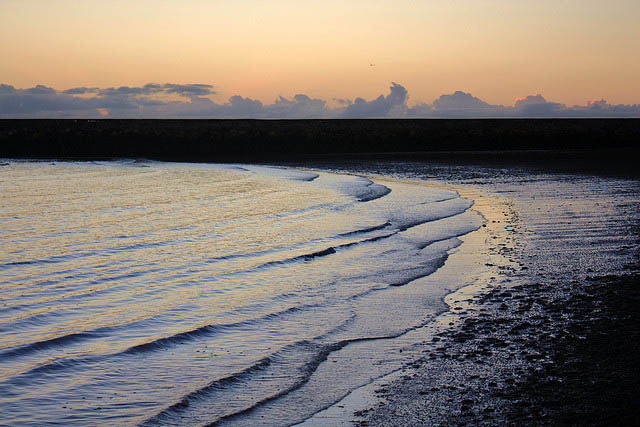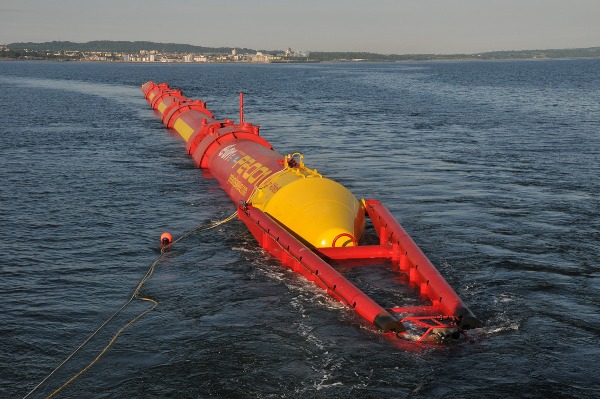Waves may not be that predictable, even though technology and forecasting has improved (from World War II, when wave forecasting began in earnest, thanks to the requirements of the D-Day landing, up through the sophisticated models used by sports organizations like Surfline today), but the tides are thoroughly predictable. We have very accurate charts detailing high and low tides, know how they shift each day, how much above the average high or below the average low they will be. This means making electricity from the ocean a thoroughly enticing idea, even if it’s one that hasn’t really been acted on.
Broadening things slightly, exploiting tidal power to do useful work is something humans have been doing for literally millennia. The Romans may have used water wheels powered by man-made tidal pools to grind grain. Skip ahead quite a ways: It wasn’t until the mid-1960s that the first large-scale tidal power plant was developed.

Let’s leave the long history aside and look to the recent past, today, and the future: What’s going on with wave power and tidal power right now, and will this ever have anything but a niche or very geographically-specific role in a low-carbon future?
Making electricity from the forces of the ocean can be split into broad categories, tidal power (which taps the very predictable action of the tides, primarily being a function of the relationship between the Earth and the Moon, though influenced by geography, shoreline, and wind) and wave power (which are generated by wind, influenced strongly by geography, as well as, in terms of breaking waves, by tides).
We’ll get into this is more detail, but wave power generally uses some sort of mechanical device that is moved by the waves well outside the surf zone to generate electricity — there have been many different designs to do this; tidal power either uses some device placed in the steam of the moving tide to generate electricity, or some sort of dam-like arrangement to channel or contain the water and then turn a turbine.
You sometimes here the term ocean power used, but in general this is being used as a synonym with wave power (devices marketed as ocean power are relying on waves to make electricity), or as a catch-all term for both wave power and tidal power technologies. I’ll use it here in the latter sense.
Let’s deal with wave power first. It’s the flashier of the two variations of ocean power, although it’s also the least proven one at scale, and probably the one with the lesser potential — even if its developers would have you believe otherwise.
There have been all sorts of interesting looking (and sounding) devices developed to make electricity from waves: The Anaconda, the Limpet, the Oyster, the Pelamis Wave Energy Converter, the Power Buoy, the SeaRaser, the Wave Dragon.
The individual configurations of these devices vary, but you can sort of tell by their names what’s going on. The Anaconda is a large snake-like device that’s tethered underwater, generating electricity as it moves. The Oyster is a big clam-shell looking device that gets moved back and forth by the movement of water. The Power Buoy moves up and down on the surface the water, the movement generating electricity. The SeaRaser does what its awful pun on a name implies: In one operating mode it can pump sea water up a nearby hill for storage until electricity is needed, generated by letting it flow back down hill, in a pumped storage arrangement; it can also generate (less) power by just powering a turbine at sea level.
Over the past several years many prototypes of these, pilot projects, and even small commercial versions have been deployed. But none have frankly amounted to much of anything.
The technology works, in the sense that electricity is generated, but making it commercial viable, either because of the finances involved or the scale at which they need to be deployed to generate sufficient amounts of electricity to be taken serious simply hasn’t happened. I have my doubts, at anything other than a very local or subsistence level, if it ever will.
Some stats to back up my intuition, from David Mackay’s sobering book “Sustainable Energy Without the Hot Air”: Taking perhaps a best-case example for wave power, the United Kingdom and it’s bountiful coastline, Mackay says, on page 74, that even using generous assumptions about the efficiency of wave power technology and a realistic level of deployment (no one would be able to line the coast with these devices), even an ideal location like Britain could generate just 4 kWh per day per person from wave power. If you haven’t read your electricity bill lately, even if you use a very modest amount of electricity, that’s a tiny fraction of your consumption.
Then there’s the amount of materials required, per unit of energy generated. Mackay uses the Pelamis as an example — perhaps a heavy one. Comparing this wave power device to a commercial wind turbine, Mackay finds that the Pelamis requires about 500 kg of materials per kilowatt, with the wind turbine coming it at just 170 kg per kW. In other words, the wind turbine is a far, far more efficient use of scarce (and carbon intensive) use of resources. Other specific wave power devices may compare more favorably, but I think this comparison probably holds, in general.

Tidal power offers more promise. Here, as I said, the technology breaks down into two broad categories: Devices placed in the tidal stream and those channelling or somehow storing the water.
Tidal turbines are the main type of device in the first category. They are what the name implies, essentially something looking like a wind turbine that’s placed underwater and gets turned by the moving water of the tide as if comes in and moves out.
Obviously places with strong currents will work better, though currents that are too strong can be rough on equipment. Back in 2008, a tidal turbine project in New York City’s East River had the blades of its turbines shredded by the power of the river — something that may seem unbelievable until you see how fast the East River can move on the tide as its channeled alongside the island of Manhattan and Long Island.
There are numerous tidal turbine projects in deployed today, too many to mention, but none is really of the size to be considered utility scale — even if in a technical sense some may be commercial, in that they are generating electricity for money.
Interesting to note, tidal turbines have also been deployed or proposed to be deployed, at least in a test capacity, in rivers — ones in the River Thames in London would be power by the movement of the tide, while ones in Ontario (part of the 15 MW Cornwall Ontario River Energy Project) rely just on the flow of the river.
The other way to generate electricity from the tides is via a tidal barrage, that is a dam across the full width of a tidal estuary. As the tide rises, water gets trapped behind the dam. As the tide falls, this water gets released back, turning turbines in the dam to generate electricity.
This is the most-deployed, and in many ways, most simple version of ocean power. There are a number of tidal power stations already built, with ones topping 1 gigawatt under construction (in South Korea), and several genuinely huge ones proposed. Some of these, in Russia, are in the tens of gigawatt range.
Perhaps the most contentious of these, or at least the one that has received the most media focus, is the 8.6 GW Severn Barrage, on the border of England and Wales.
Some sort of dam has been proposed for the Severn as far back as 1849 (though then obviously not for electricity, but rather for flood control). The most recent version proposed to generate 5% of Britain’s electricity — albeit at a cost that a coalition of UK-based environmental groups, including the Royal Society for the Protection of Birds and WWF-UK, have said is far more expensive than generating the same amount of electricity from other clean energy sources.
On a more modest scale, a new proposed tidal power lagoon, off Swansea may point the way in which tidal power can be developed in a more environmentally-sensitive way. In this case a curving seawall would be built with a turbine house it that could generate electricity as the tide moves in both directions. The 250 MW project would generate more electricity than is needed in Swansea itself.
Going back to Mackey, cited above, the potential of tidal power in Britain is about four times that off wave power. Still not enough to support the high-energy use norms of today, but able to make a more significant contribution.
So what’s the overall potential for tidal power, in more specific terms, and bringing it back to the United States? Well, it’s hugely location dependent. A survey conducted by the Georgia Institute of Technology found that in Alaska tidal power could generate 16 terawatt-hours of electricity a year (four times last of the Hoover Dam). In the entire lower-48 states, that drops to 0.6 TWh/year. You need significant tidal shifts to really exploit the technology for electricity.